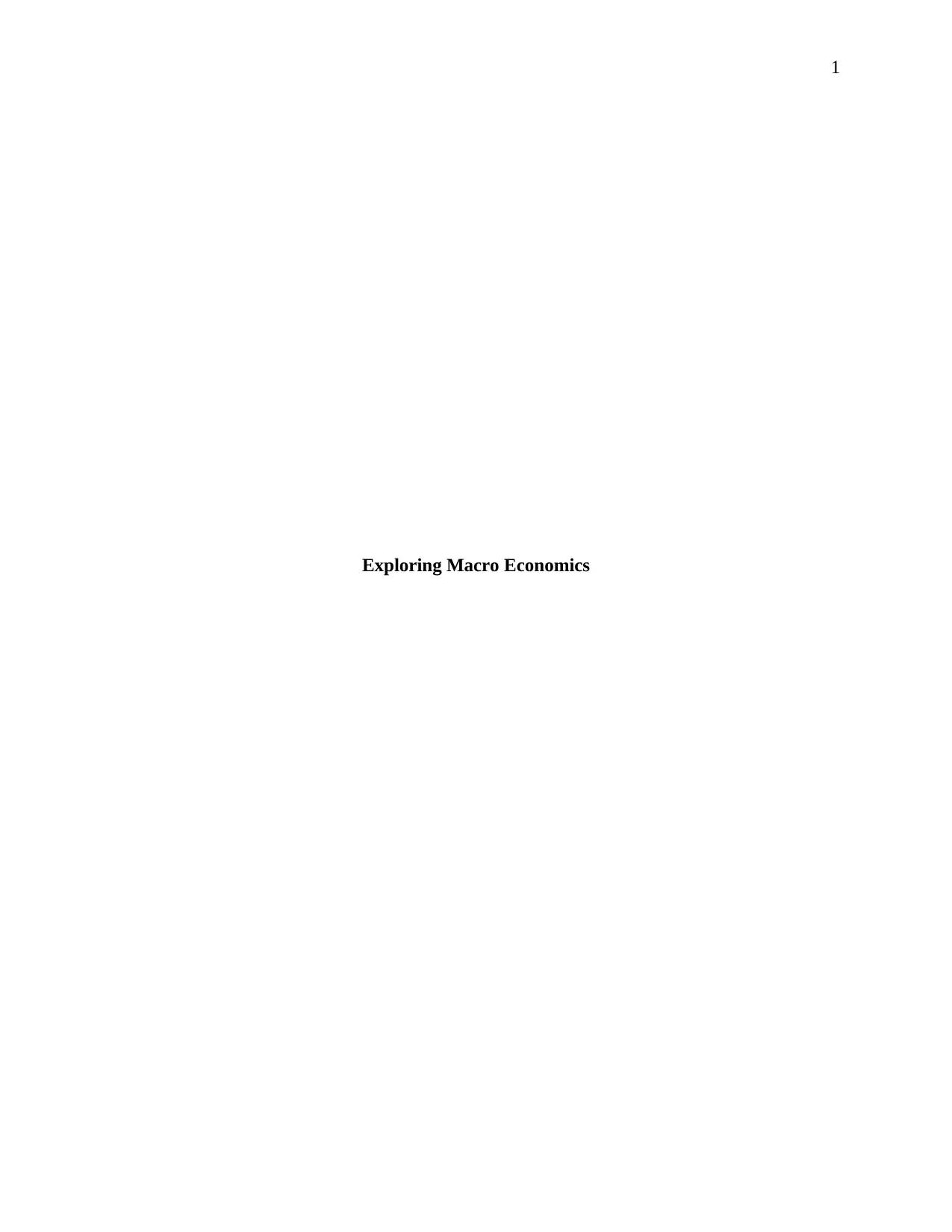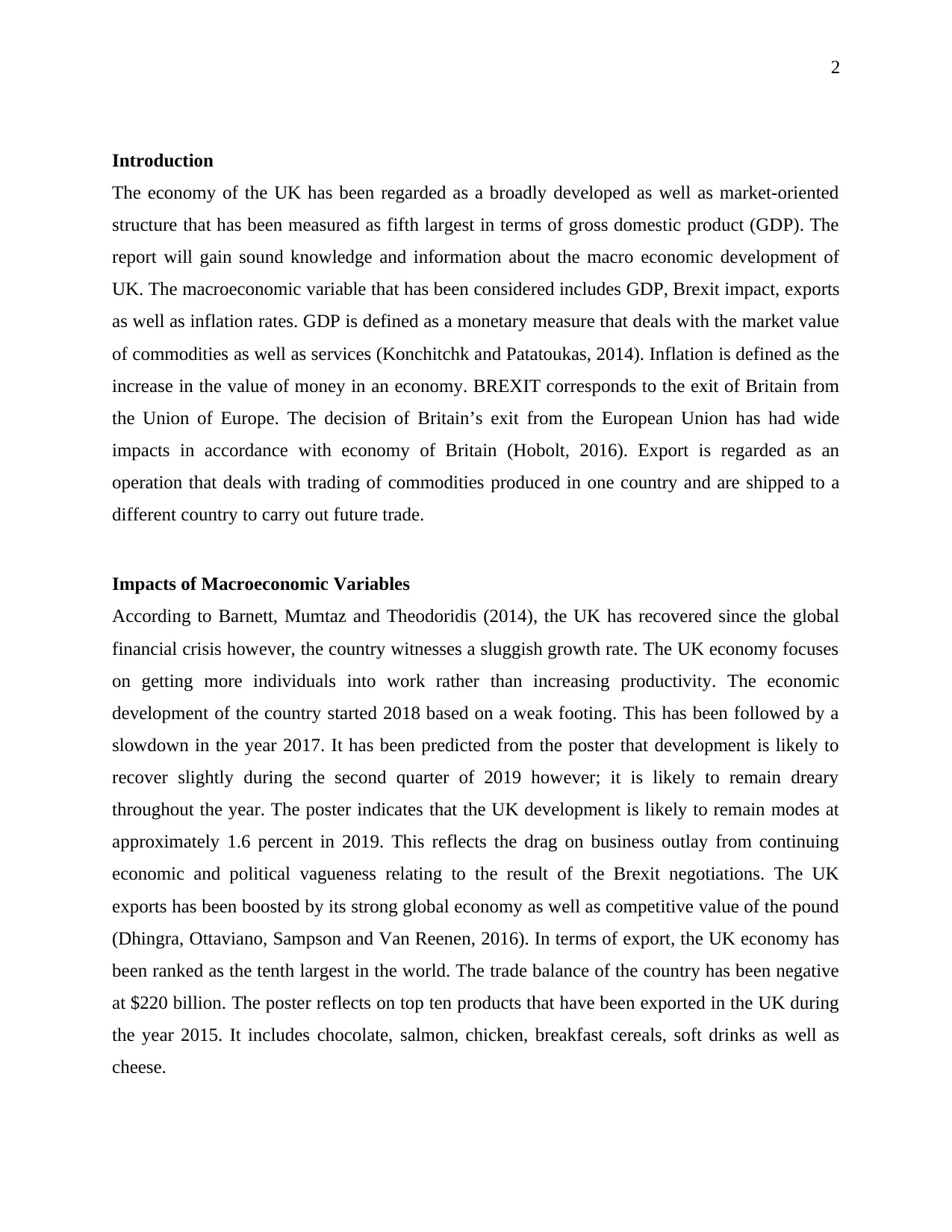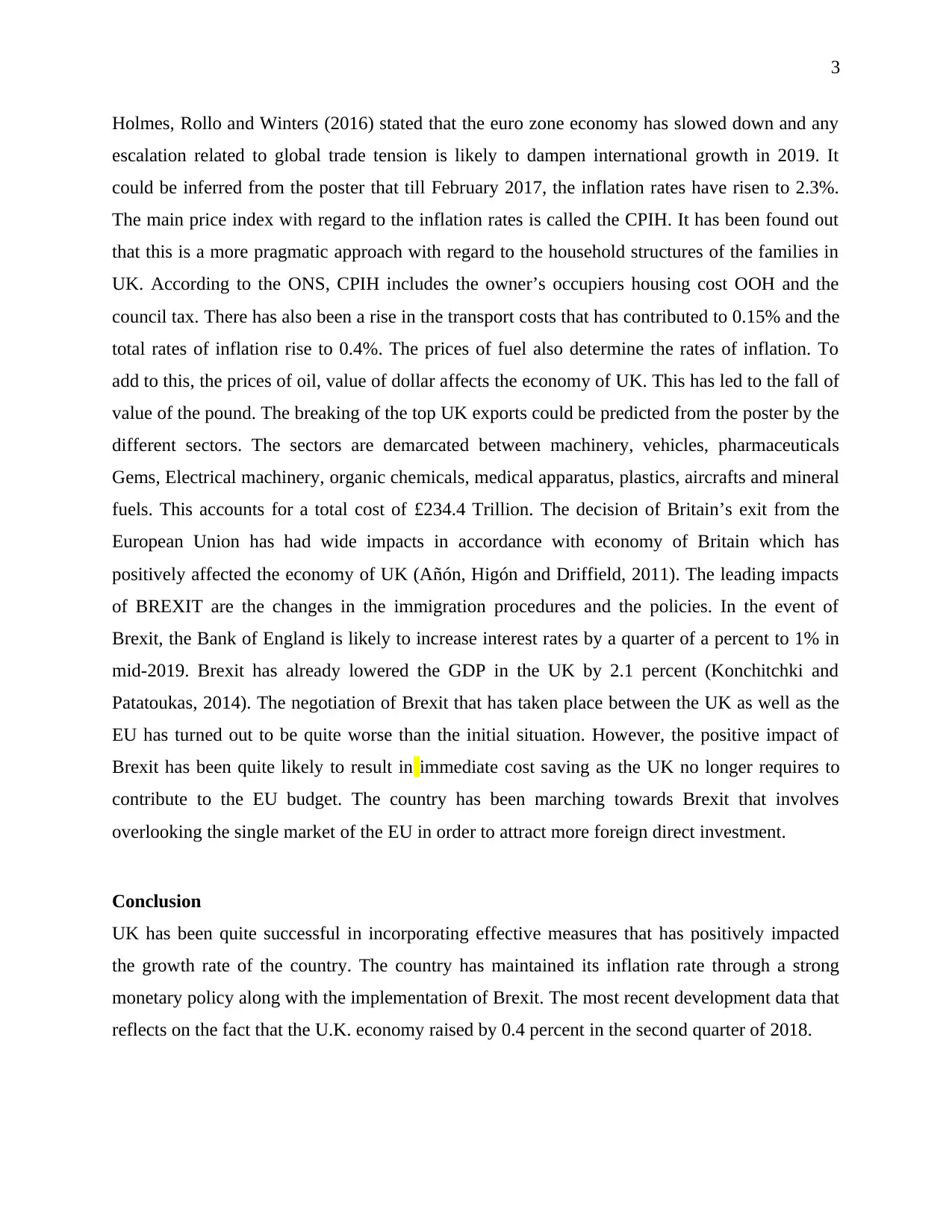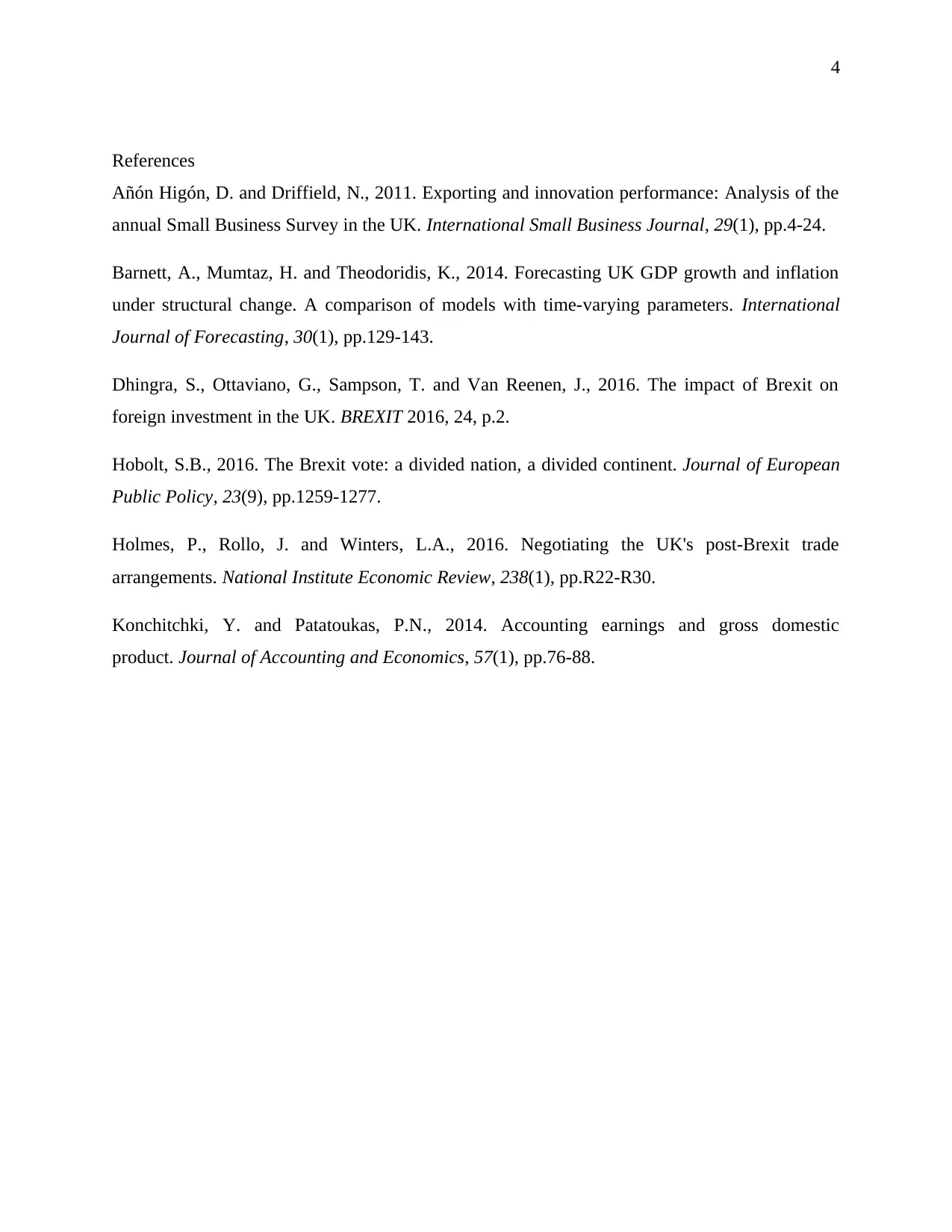MS40043E - Analyzing UK's Macroeconomic Factors: A Detailed Report
VerifiedAdded on 2023/04/05
|4
|968
|77
Report
AI Summary
This report provides an analysis of the UK's macroeconomic environment, focusing on key variables such as GDP, exports, and inflation rates, while also considering the impact of Brexit. The UK economy, characterized as a developed and market-oriented structure, has faced challenges and opportunities since the global financial crisis, including a sluggish growth rate and the complexities of Brexit negotiations. The report highlights that while the UK has seen recovery, its economic development has been moderate, influenced by uncertainties surrounding Brexit. The analysis also covers the UK's trade balance, export products, and the factors affecting inflation rates, such as transport costs and fuel prices. The report concludes that the UK has been successful in maintaining its inflation rate through monetary policy and has the potential for cost savings due to Brexit, but it also faces challenges in navigating the single market of the EU. Desklib provides access to this report and many other solved assignments for students.

1
Exploring Macro Economics
Exploring Macro Economics
Paraphrase This Document
Need a fresh take? Get an instant paraphrase of this document with our AI Paraphraser

2
Introduction
The economy of the UK has been regarded as a broadly developed as well as market-oriented
structure that has been measured as fifth largest in terms of gross domestic product (GDP). The
report will gain sound knowledge and information about the macro economic development of
UK. The macroeconomic variable that has been considered includes GDP, Brexit impact, exports
as well as inflation rates. GDP is defined as a monetary measure that deals with the market value
of commodities as well as services (Konchitchk and Patatoukas, 2014). Inflation is defined as the
increase in the value of money in an economy. BREXIT corresponds to the exit of Britain from
the Union of Europe. The decision of Britain’s exit from the European Union has had wide
impacts in accordance with economy of Britain (Hobolt, 2016). Export is regarded as an
operation that deals with trading of commodities produced in one country and are shipped to a
different country to carry out future trade.
Impacts of Macroeconomic Variables
According to Barnett, Mumtaz and Theodoridis (2014), the UK has recovered since the global
financial crisis however, the country witnesses a sluggish growth rate. The UK economy focuses
on getting more individuals into work rather than increasing productivity. The economic
development of the country started 2018 based on a weak footing. This has been followed by a
slowdown in the year 2017. It has been predicted from the poster that development is likely to
recover slightly during the second quarter of 2019 however; it is likely to remain dreary
throughout the year. The poster indicates that the UK development is likely to remain modes at
approximately 1.6 percent in 2019. This reflects the drag on business outlay from continuing
economic and political vagueness relating to the result of the Brexit negotiations. The UK
exports has been boosted by its strong global economy as well as competitive value of the pound
(Dhingra, Ottaviano, Sampson and Van Reenen, 2016). In terms of export, the UK economy has
been ranked as the tenth largest in the world. The trade balance of the country has been negative
at $220 billion. The poster reflects on top ten products that have been exported in the UK during
the year 2015. It includes chocolate, salmon, chicken, breakfast cereals, soft drinks as well as
cheese.
Introduction
The economy of the UK has been regarded as a broadly developed as well as market-oriented
structure that has been measured as fifth largest in terms of gross domestic product (GDP). The
report will gain sound knowledge and information about the macro economic development of
UK. The macroeconomic variable that has been considered includes GDP, Brexit impact, exports
as well as inflation rates. GDP is defined as a monetary measure that deals with the market value
of commodities as well as services (Konchitchk and Patatoukas, 2014). Inflation is defined as the
increase in the value of money in an economy. BREXIT corresponds to the exit of Britain from
the Union of Europe. The decision of Britain’s exit from the European Union has had wide
impacts in accordance with economy of Britain (Hobolt, 2016). Export is regarded as an
operation that deals with trading of commodities produced in one country and are shipped to a
different country to carry out future trade.
Impacts of Macroeconomic Variables
According to Barnett, Mumtaz and Theodoridis (2014), the UK has recovered since the global
financial crisis however, the country witnesses a sluggish growth rate. The UK economy focuses
on getting more individuals into work rather than increasing productivity. The economic
development of the country started 2018 based on a weak footing. This has been followed by a
slowdown in the year 2017. It has been predicted from the poster that development is likely to
recover slightly during the second quarter of 2019 however; it is likely to remain dreary
throughout the year. The poster indicates that the UK development is likely to remain modes at
approximately 1.6 percent in 2019. This reflects the drag on business outlay from continuing
economic and political vagueness relating to the result of the Brexit negotiations. The UK
exports has been boosted by its strong global economy as well as competitive value of the pound
(Dhingra, Ottaviano, Sampson and Van Reenen, 2016). In terms of export, the UK economy has
been ranked as the tenth largest in the world. The trade balance of the country has been negative
at $220 billion. The poster reflects on top ten products that have been exported in the UK during
the year 2015. It includes chocolate, salmon, chicken, breakfast cereals, soft drinks as well as
cheese.

3
Holmes, Rollo and Winters (2016) stated that the euro zone economy has slowed down and any
escalation related to global trade tension is likely to dampen international growth in 2019. It
could be inferred from the poster that till February 2017, the inflation rates have risen to 2.3%.
The main price index with regard to the inflation rates is called the CPIH. It has been found out
that this is a more pragmatic approach with regard to the household structures of the families in
UK. According to the ONS, CPIH includes the owner’s occupiers housing cost OOH and the
council tax. There has also been a rise in the transport costs that has contributed to 0.15% and the
total rates of inflation rise to 0.4%. The prices of fuel also determine the rates of inflation. To
add to this, the prices of oil, value of dollar affects the economy of UK. This has led to the fall of
value of the pound. The breaking of the top UK exports could be predicted from the poster by the
different sectors. The sectors are demarcated between machinery, vehicles, pharmaceuticals
Gems, Electrical machinery, organic chemicals, medical apparatus, plastics, aircrafts and mineral
fuels. This accounts for a total cost of £234.4 Trillion. The decision of Britain’s exit from the
European Union has had wide impacts in accordance with economy of Britain which has
positively affected the economy of UK (Añón, Higón and Driffield, 2011). The leading impacts
of BREXIT are the changes in the immigration procedures and the policies. In the event of
Brexit, the Bank of England is likely to increase interest rates by a quarter of a percent to 1% in
mid-2019. Brexit has already lowered the GDP in the UK by 2.1 percent (Konchitchki and
Patatoukas, 2014). The negotiation of Brexit that has taken place between the UK as well as the
EU has turned out to be quite worse than the initial situation. However, the positive impact of
Brexit has been quite likely to result in immediate cost saving as the UK no longer requires to
contribute to the EU budget. The country has been marching towards Brexit that involves
overlooking the single market of the EU in order to attract more foreign direct investment.
Conclusion
UK has been quite successful in incorporating effective measures that has positively impacted
the growth rate of the country. The country has maintained its inflation rate through a strong
monetary policy along with the implementation of Brexit. The most recent development data that
reflects on the fact that the U.K. economy raised by 0.4 percent in the second quarter of 2018.
Holmes, Rollo and Winters (2016) stated that the euro zone economy has slowed down and any
escalation related to global trade tension is likely to dampen international growth in 2019. It
could be inferred from the poster that till February 2017, the inflation rates have risen to 2.3%.
The main price index with regard to the inflation rates is called the CPIH. It has been found out
that this is a more pragmatic approach with regard to the household structures of the families in
UK. According to the ONS, CPIH includes the owner’s occupiers housing cost OOH and the
council tax. There has also been a rise in the transport costs that has contributed to 0.15% and the
total rates of inflation rise to 0.4%. The prices of fuel also determine the rates of inflation. To
add to this, the prices of oil, value of dollar affects the economy of UK. This has led to the fall of
value of the pound. The breaking of the top UK exports could be predicted from the poster by the
different sectors. The sectors are demarcated between machinery, vehicles, pharmaceuticals
Gems, Electrical machinery, organic chemicals, medical apparatus, plastics, aircrafts and mineral
fuels. This accounts for a total cost of £234.4 Trillion. The decision of Britain’s exit from the
European Union has had wide impacts in accordance with economy of Britain which has
positively affected the economy of UK (Añón, Higón and Driffield, 2011). The leading impacts
of BREXIT are the changes in the immigration procedures and the policies. In the event of
Brexit, the Bank of England is likely to increase interest rates by a quarter of a percent to 1% in
mid-2019. Brexit has already lowered the GDP in the UK by 2.1 percent (Konchitchki and
Patatoukas, 2014). The negotiation of Brexit that has taken place between the UK as well as the
EU has turned out to be quite worse than the initial situation. However, the positive impact of
Brexit has been quite likely to result in immediate cost saving as the UK no longer requires to
contribute to the EU budget. The country has been marching towards Brexit that involves
overlooking the single market of the EU in order to attract more foreign direct investment.
Conclusion
UK has been quite successful in incorporating effective measures that has positively impacted
the growth rate of the country. The country has maintained its inflation rate through a strong
monetary policy along with the implementation of Brexit. The most recent development data that
reflects on the fact that the U.K. economy raised by 0.4 percent in the second quarter of 2018.
⊘ This is a preview!⊘
Do you want full access?
Subscribe today to unlock all pages.

Trusted by 1+ million students worldwide

4
References
Añón Higón, D. and Driffield, N., 2011. Exporting and innovation performance: Analysis of the
annual Small Business Survey in the UK. International Small Business Journal, 29(1), pp.4-24.
Barnett, A., Mumtaz, H. and Theodoridis, K., 2014. Forecasting UK GDP growth and inflation
under structural change. A comparison of models with time-varying parameters. International
Journal of Forecasting, 30(1), pp.129-143.
Dhingra, S., Ottaviano, G., Sampson, T. and Van Reenen, J., 2016. The impact of Brexit on
foreign investment in the UK. BREXIT 2016, 24, p.2.
Hobolt, S.B., 2016. The Brexit vote: a divided nation, a divided continent. Journal of European
Public Policy, 23(9), pp.1259-1277.
Holmes, P., Rollo, J. and Winters, L.A., 2016. Negotiating the UK's post-Brexit trade
arrangements. National Institute Economic Review, 238(1), pp.R22-R30.
Konchitchki, Y. and Patatoukas, P.N., 2014. Accounting earnings and gross domestic
product. Journal of Accounting and Economics, 57(1), pp.76-88.
References
Añón Higón, D. and Driffield, N., 2011. Exporting and innovation performance: Analysis of the
annual Small Business Survey in the UK. International Small Business Journal, 29(1), pp.4-24.
Barnett, A., Mumtaz, H. and Theodoridis, K., 2014. Forecasting UK GDP growth and inflation
under structural change. A comparison of models with time-varying parameters. International
Journal of Forecasting, 30(1), pp.129-143.
Dhingra, S., Ottaviano, G., Sampson, T. and Van Reenen, J., 2016. The impact of Brexit on
foreign investment in the UK. BREXIT 2016, 24, p.2.
Hobolt, S.B., 2016. The Brexit vote: a divided nation, a divided continent. Journal of European
Public Policy, 23(9), pp.1259-1277.
Holmes, P., Rollo, J. and Winters, L.A., 2016. Negotiating the UK's post-Brexit trade
arrangements. National Institute Economic Review, 238(1), pp.R22-R30.
Konchitchki, Y. and Patatoukas, P.N., 2014. Accounting earnings and gross domestic
product. Journal of Accounting and Economics, 57(1), pp.76-88.
1 out of 4
Related Documents
Your All-in-One AI-Powered Toolkit for Academic Success.
+13062052269
info@desklib.com
Available 24*7 on WhatsApp / Email
![[object Object]](/_next/static/media/star-bottom.7253800d.svg)
Unlock your academic potential
Copyright © 2020–2025 A2Z Services. All Rights Reserved. Developed and managed by ZUCOL.





